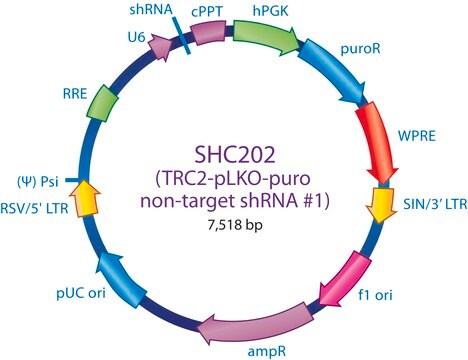Key Documents
SHC002V
MISSION® pLKO.1-puro Non-Mammalian shRNA Control Transduction Particles
Targets no known mammalian genes
Synonim(y):
MISSION®, MISSION® Control Transduction Particles
About This Item
Polecane produkty
Poziom jakości
100
200
linia produktu
MISSION®
stężenie
≥1x106 VP/ml (via p24 assay)
metody
capture ELISA: 106 TU/mL using p24
Warunki transportu
dry ice
temp. przechowywania
−70°C
Szukasz podobnych produktów? Odwiedź Przewodnik dotyczący porównywania produktów
Powiązane kategorie
Opis ogólny
Small interfering RNAs (siRNAs) expressed from short hairpin RNAs (shRNAs) are a powerful way to mediate gene specific RNA interference (RNAi) in mammalian cells. The MISSION product line is based on a viral vector-based RNAi library against annotated mouse and human genes. shRNAs that generate siRNAs intracellularly are expressed from amphotropic lentivirus viral particles, allowing screening in a wide range of mammalian cell lines. In these cell lines, MISSION shRNA clones permit rapid, cost efficient loss-of-function and genetic interaction screens.
The lentiviral transduction particles are produced from an shRNA lentiviral non-target control plasmid. It is useful as a negative control in experiments with the MISSION shRNA target sets.
Unlike murine-based MMLV or MSCV retroviral systems, lentiviral-based particles permit efficient infection and integration of the specific shRNA construct into differentiated and non-dividing cells, such as neurons and dendritic cells,1 overcoming low transfection and integration difficulties when using these cell lines. Self-inactivating replication incompetent viral particles are produced in packaging cells (HEK293T) by co-transfection with compatible packaging plasmids.2-3
In addition, the lentiviral transduction particles are pseudotyped with an envelope G glycoprotein from vesicular stomatitis virus (VSV-G), allowing transduction of a wide variety of mammalian cells.4 The lentiviral transduction particles are titered via a p24 antigen ELISA assay and pg/ml of p24 are then converted to transducing units per ml using a conversion factor. The conversion can be viewed at: www.tronolab.com.
To see more application data, protocols, vector maps visit sigma.com/shrna.
Zastosowanie
Informacje prawne
polecane
Kod klasy składowania
12 - Non Combustible Liquids
Klasa zagrożenia wodnego (WGK)
WGK 3
Temperatura zapłonu (°F)
Not applicable
Temperatura zapłonu (°C)
Not applicable
Środki ochrony indywidualnej
Eyeshields, Gloves, multi-purpose combination respirator cartridge (US)
Certyfikaty analizy (CoA)
Poszukaj Certyfikaty analizy (CoA), wpisując numer partii/serii produktów. Numery serii i partii można znaleźć na etykiecie produktu po słowach „seria” lub „partia”.
Masz już ten produkt?
Dokumenty związane z niedawno zakupionymi produktami zostały zamieszczone w Bibliotece dokumentów.
Klienci oglądali również te produkty
Produkty
Enhancing Lentiviral Transduction Efficiency
Porównano metody transdukcji lentiwirusowej komórek Jurkat. Spinokulację porównano z całonocną inkubacją z polibarenem (bromkiem heksadimetryny) i płytkami pokrytymi fibroneką.
Protokoły
Detailed procedure for how to perform a lentiviral transduction of MISSION shRNA lentiviral particles to achieve a stable long term silencing and phenotypic change.
Szczegółowa procedura przeprowadzania transdukcji lentiwirusowej cząsteczek MISSION shRNA w celu uzyskania stabilnego, długotrwałego wyciszenia i zmiany fenotypu.
This detailed procedure allows you to transduce Mouse Embryonic Fibroblasts (MEF) using MISSION ExpressMag Super Magnetic Kit.
Nasz zespół naukowców ma doświadczenie we wszystkich obszarach badań, w tym w naukach przyrodniczych, materiałoznawstwie, syntezie chemicznej, chromatografii, analityce i wielu innych dziedzinach.
Skontaktuj się z zespołem ds. pomocy technicznej







